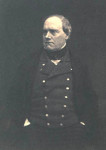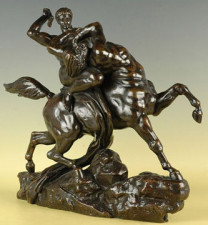
Antoine-Louis Barye
French, 1796-1875
Theseus Slaying the Minotaur, 1848 ca.
bronze
15 7/8 × 19 1/2 in.
SBMA, Museum purchase, Vote for Art Funds
1983.5

Photo of Antoine-Louis Bayre in 1855 – 1859, by Nadar, French, Salt print
RESEARCH PAPER
Referred to as the "Michelangelo of the menagerie" by critic Théophile Gautier, Antoine-Louis Barye was about sixty when he posed for Nadar. The son of a Parisian jeweler, he studied animal anatomy thoroughly in books, in laboratories, and at the zoo. When a lion died, he and Eugène Delacroix dissected it. Here his stern visage reflects the notably taciturn man who, although he taught drawing, rarely spoke to his students, correcting their work simply by retouching. The overall effect of self-contained if melancholy dignity, of a man who has survived adversity and is beholden to no one, accords well with contemporary descriptions of Barye. His connection with Nadar was probably established through the painters who were friends of both. Barye was seldom photographed, and this image by Nadar, one of the few existing portraits, was later used as the basis for an etching.
---------
This small sculpture was Purchased early in 1983 by the Santa Barbara Museum of Art from the Shepherd Gallery, Associates, New York City. The sculpture is of bronze with dark brown and greenish patination on a rectangular base. After casting, the signature "Barye" was incised on the base behind Theseus' left heel. A gold seal inserted in a corner of the base reads "Collection / Paris / F. Barbedienne". Incised on the base after casting, starting from the gold seal, is the inscription "F. Barbedienne, Foundeur".
In the winter of 1982-83, when the museum's annual giving campaign was devoted to acquisitions, a "Vote for Art" contest was announced by the museum. Five diverse art objects, including "Theseus and the Minotaur", were displayed in the museum lobby; and the public was informed that for each ten dollar contribution to the museum a vote could be cast by the donor for his or her favorite of the five art works. At the end of the contest, the object receiving the most votes would be purchased by the museum. In fact enough money was donated to purchase all five art works.
The subject of this sculpture is the moral triumph of the heroic Theseus over the bestial Minotaur. The monstrous creature, which was half man and half bull, was confined to a labyrinth built by Daedalus for King Minos on the island of Crete. The Minotaur survived on a regular tribute of seven fair youths and seven fair maidens exacted from Athens. Theseus, who was the son of the Athenian king, Aegeus, sailed to Crete, found his way into the labyrinth with the help of Minos' daughter, Ariadne, and slew the Minotaur, thus freeing the sacrificial youths and maidens.
Our sculpture is composed of two strongly contrasting figures. Theseus is pyramidal, his feet firmly planted on the ground. His is a solid, stable, upright shape. The figure of the Minotaur is unstable and precariously balanced. We sense that the beast is slowly slipping to defeat and death. Its clawing limbs enwrap and lead our eyes around our hero's body. Theseus is rigid and planar in opposition to the twisting, turning, space-invading Minotaur. This contrast of the rectilinear and the serpentine was often found in Barye's animal combat designs and is characteristic of his style at this time.
The bulk of the two figures is also quite different. The Minotaur's body is chunky and herculean whereas Theseus is more lightly muscled, making him appear more wiry and agile. The exclamation point of Theseus' sword aimed directly at the monster's brain leaves no doubt as to the victor in this combat. The strong line of the pointing sword between the two heads suggests that human intellect, rather than strength alone, has triumphed.
Antoine Louis Barye, who created this sculpture, was born in Paris in 1796 and died there in 1875. His lifetime, consequently, encompassed both the neoclassic and romantic periods of 19th century French art. His father was a goldsmith. Barye learned the discipline of his father's craft at an early age. Many of its aspects such as clearness of form, love of detail and delight in imagery in miniature are apparent in his mature sculpture. Later he often returned to decorative metalwork for income when his sculptures failed to attract purchasers.
From 1823-31 Barge worked as an artisan for the goldsmith Fauconnier perhaps creating for him Barge's first small sculptures of animals as independent images. During this time Barye studied preserved animal specimens and skeletons in the Musee d'Anatomie Comparee; he observed dissections of animals and read recent scholarly papers on animal species; and he studied living animals at the Jardin des Plantes Zoo. In his circle of friends were many French painters such as Corot, Millet, and other members of the Barbizon School. However his work was most influenced by the Romantics: Baron Gros with whom he studied, by Gericault, and by Delacroix who admired his work and spent time with him at the zoo. From these three, Barye developed a taste for the exotic and the violent. Many of his best known bronzes skillfully depict wild beasts locked in deadly combat.
The appearance of Barye's sculpture "Tiger Devouring a Gavial of the Gances" at the Salon of 1831 thrust him into the limelight as a mature gifted and daring sculptor. Encouraged by the royal house of Orleans, he exhibited "Lion Crushing a Serpent" which he created for his royal patrons at the Salon of 1833. In May of that year he was made a chevalier of the Legion of Honor.
Shortly after this, the Duc d'Orleans commissioned a surtout de table or banquet table decoration, a large and complicated project involving four separate sculptures done by Barye and several other artists. The project was never completed due to the accidental death of the duke, but Barye's work was finished. It includes five great hunt groups: "Tiger Hunt", "Lion Hunt", "Elk Hunt", "Bear Hunt", and "Bull Hunt". There are also four smaller groups: "Python Killing a Gnu", "Lion Devouring a Boar", "Eagle and Ibex" and "Antelope Overthrown by a Tiger" . This creative outpouring was the apogee of Barye's art and of romantic sculpture.
In 1845 as his Orleanist patronage declined, Barye formed a partnership, Barye et Cie, with Emile Martin to produce and market his bronzes. In Barye's workshop, serial production of an artist's designs first took place, a sign of the rise of the middle class as a major source of artistic patronage in Europe.
In 1854 Barye became master of zoological drawing in the Musee d'Historie Naturelle of Paris, a position which he held until his death. One of his pupils was Auguste Rodin. Barye received the Cross of the Legion of Honor in 1855 and became a member of the prestigious Institut de France in 1868.
An overview of Barye' s work reveals that almost all of his finished pieces are done in bronze. The coldness and the restrictions of marble were not suited to Barye's fiery, romantic concepts. Only hot, malleable bronze which could be boldly worked, finished bronze with its colorful, warmly patinated surface was appropriate for the dramatic, deadly struggles which he chose to portray.
Carol M. Smith
March, 1984
Bibliography
Janson, H.W. History of Art . Englewood Cliffs, N.J.: Prentice-Hall, Inc. York. N . Y.: Harry N. Abrams, Inc., 1962 .
Encyclopedia Britannica. Vol 3 pp. 211-212.
Pivar, Stuart. "The Barye Bronzes", Antique Collectors' Club . 1974, pp. 12-20.
Johnston, Wm. R. "The Barye Collection", Apollo Vol. C, No. 153. Nov. 1974. pp. 408-409.
Los Angeles County Museum of Art, "The Romantics to Rodin", 1980.
Prepared for SBMA Docent website 2008 LG.

Theseus Slaying the Minotaur is one of two sculptures executed by Barye in the classic style dealing with the mythological hero Theseus. The other is entitled "Theseus and the Centaur."
SBMA CURATORIAL LABELS
The moment captured is that of the final vanquishing of the terrifying man-monster by the Athenian hero Theseus, who braved the labyrinth so that the promised seven young men and women would not be sacrificed to the Minotaur, as commanded by King Minos. Barye’s sculpture, despite the violent struggle that it depicts, exudes an almost uncanny calm in accordance with Neoclassical precepts. The two bodies are as if locked in a fearsome dance, with arms and legs echoing each other. Theseus’s expression is oddly tranquil, so confident is he in his purpose. When Barye first exhibited the original cast in the 1843 Salon, it was rejected by the academic judges. He had to wait until the regime change of the short-lived Second Republic for the Salon juries to acknowledge the brilliance of his sculptural idea when it was accepted for exhibition in 1851. Barye is best known as the most celebrated animalier of the Romantic period, even if this subject more clearly resonates with his earlier training under the neoclassical sculptor François-Joseph Bosio.
- Ridley-Tree Reopening, 2021
